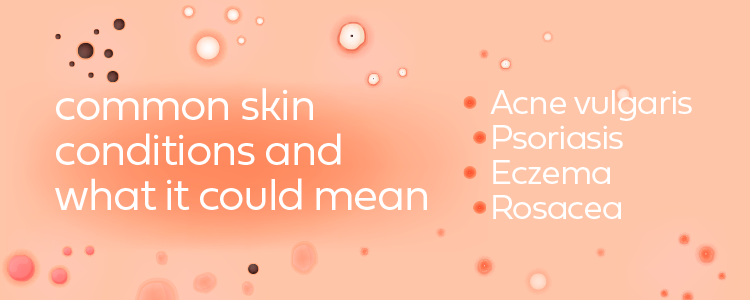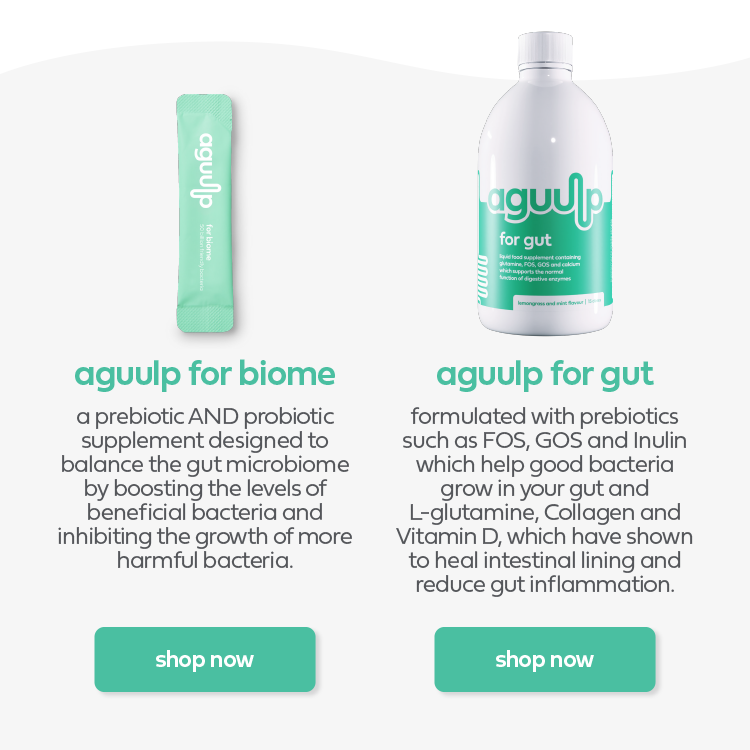Gut-Skin Axis Uncovered
What is the relationship between gut health and skin health

The skin is the largest organ of the human body and has many functions including barrier protection, thermoregulation, sensation, excretion, detoxification, absorption, and Vitamin D production. The skin is colonised by a diverse array of microorganisms, known as the skin microbiome. The composition of the skin microbiome is unique to an individual and varies according to factors including age, gender, and environment.
The composition of the skin microbiome changes throughout life due to changes in hormonal levels and psychological stressors that increase as we age. It is believed the skin microbiome can influence health and has been shown to play a significant role in in aspects of health such as immune reactions, wound healing, colonisation of pathogens and skin disorders.
Research, as far back as the early 20th century, shows that both the skin and gut microbiome are intrinsically linked and that skin conditions can be strongly affected by the gut flora. The skin microbiome works with the immune system (which is predominantly found in the gut) to produce antimicrobials when necessary to help manage inflammation. A healthy skin microflora is needed to help maintain the integrity of the skin’s barrier.
The gut microbiome has been implicated in many common skin disorders such as eczema, psoriasis and acne. The gut microbiome influences our skin health through its effects on our immune health and inflammation. It is estimated that 70% of our immune cells are found in the gut, and our gut microbes can affect the function of immune cells.
The relationship between the gut and the skin is known as the ‘gut-skin axis’ where communication between the two systems is regulated by signals from both the adaptive and innate immune systems.
Factors such as the following can impact the relationship between the gut and the health of the skin, leading to an imbalance of the skin microbiome which in turn stimulates a defensive response by the immune system:
- Environmental toxins
- Cosmetics
- Medications
- Allergens
- Pathogens
- Injuries
When there is an imbalance of gut bacteria (known as dysbiosis), this has a negative effect on our immune responses, triggering inflammation in the body and leading to the development of skin disorders such as those mentioned above.
Another way in which the gut is thought to play a significant role in skin health is in relation to the integrity of the intestinal lining. In cases where the intestinal lining is compromised (which can occur in response to dysbiosis, inflammation or infection in the gut), this can create large gaps in the gut wall (known as leaky gut), allowing the passage of the gut contents into circulation triggering an immune response and inflammation in the body, leading to the development of skin conditions.
Common skin conditions to look out for and what It could mean

Acne vulgaris
Characterised by papules (red bumps) and pustules (whiteheads) and often referred to as ‘spots’. It can be caused by inflammation of the skin, where excessive sebum (the skin’s natural oil) and dead skin cells block the follicles in the skin, leading to the appearance of blackheads and the development of localised infection and inflammation.
Another cause of an inflammatory reaction associated with acne is the colonisation of the skin with the bacteria Propionibacterium acnes, which is found to be common in acne sufferers.
The composition of the skin microbiome is believed to be one of the key reasons in the development of acne vulgaris. However, studies show that an imbalance of gut bacteria is commonly associated with acne. Acne is also triggered by factors such as hormones, diet, and the environment.
Acne may also be caused by toxic overload: a condition where toxins are not eliminated from the body properly, resulting in toxins being reabsorbed and the body uses the skin as a channel of elimination, resulting in the development of acne. Toxic overload can occur if the digestive system is not functioning properly. Signs to look out for which may indicate your bowels are not working efficiently may include:
- sluggish bowel movements (constipation)
- excess burping, bloating and/or flatulence.
Research shows that individuals with acne are more likely to suffer with digestive issues such as constipation, bloating and acid reflux. Furthermore, research also shows that those who suffer with constipation are more likely to have dysbiosis and leaky gut when compared with healthy individuals.
Psoriasis
Psoriasis is a common inflammatory skin disease where red patches of skin are covered with white scales. Symptoms include sharply bordered rashes or plaques covered with overlapping silvery scales, which occur mainly on the scalp, the backside of the wrists, elbows, knees, buttocks, and ankles. In addition to affecting the skin, psoriasis can cause an inflammatory form of arthritis and affect the nails.
Psoriasis is caused by a pileup of skin cells that have replicated too rapidly. The rate at which skin cells divide in psoriasis is roughly one thousand times greater than in normal skin. Other factors, which appear to cause or contribute to psoriasis include:
- Incomplete protein digestion
- Bowel toxaemia (a condition where harmful toxins build up in the intestines due to various factors)
- Impaired liver function
- Alcohol consumption
- Excessive consumption of animal fats
- Nutritional factors
- Stress
Psoriasis is also associated with altered skin microbiome and diversity of the microbiome- both of which are prominent factors in the development of this condition, according to research.
Psoriasis may also be triggered by an infection in the gut or elsewhere in the body. The toxins produced by the bacteria or virus trigger an immune response which increases inflammatory chemicals which can cause a flare up of the condition. It is very common for people with psoriasis to have problems with digestion.
Eczema
Eczema is an inflammatory and immune mediated skin condition. Colonisation of gut microbes is essential for a healthy immune system. The prevalence of conditions such as eczema are increasing and are associated with low exposure to bacteria which are needed for a healthy immune system. Low exposure to the bacteria that is needed for a healthy immune system is thought to occur due to several reasons including excessive hand washing and antibiotic usage/resistance.
Studies show that dysbiosis of both the skin and gut microbiome are associated with an altered immune response and to the development of skin diseases, including eczema. Increased intestinal permeability (also known as leaky gut) is also associated with eczema.
The gut microbiome plays an important role in maintaining the integrity of the gut lining. An imbalance of good bacteria in the gut can allow opportunistic pathogens and bacteria to proliferate, irritate, and inflame the gut wall, causing impaired function of the intestinal barrier and the potential for an immune reaction, leading to the development of inflammatory conditions such as eczema.
Rosacea
A skin condition that causes blushing, small bumps and visible blood vessels on the face, is often mistaken for acne, however, redness associated with acne tends to be located around individual spots anywhere on the face or body, while rosacea skin flushing more commonly occurs in the centre of the face. Research indicates that there may be links between rosacea and the health of the gut.
Our top tips to look after this relationship

Whole foods: to ensure optimal intake of vital nutrients for the health of the skin and the gut, the diet should be based around whole foods-i.e. foods that are in their natural state and minimally processed. Processed, fried, and refined foods should be avoided since these foods promote and aggravate inflammation in the body. Examples of healthy whole foods include:
- whole grains such as millet, buckwheat, quinoa, kamut, teff, couscous, black and wild rice
dark green leafy vegetables - oily fish
- lean white meats such as turkey and chicken
- nuts and seeds and cold pressed oils such as olive, flaxseed and walnut oils
- Green vegetables contain a phytonutrient called diindolylmethane (DIM) which has been shown to have anti-inflammatory effects.
Limit sugar intake: Foods that contain high amounts of sugar are particularly pro-inflammatory, as sugar causes a huge rise in various cytokines (messenger molecules of the immune system) that interfere with the immune system and cause inflammation. Sugar also allows negative microbes to proliferate in the gut, leading to dysbiosis. Diets that are high in sugar have been shown to exacerbate acne and other skin conditions.
Drink plenty of water: Keeping hydrated is essential for bowel regularity and a heathy gut. Water also flushes toxins out of the body, preventing them from accumulating in the skin. It also carries nutrients to cells, and provides moisture and hydration to the skin. The recommended amount for water intake is 2 litres per day (equivalent to approximately 8 small glasses). If you are not currently consuming this amount, it is important to build up to this amount gradually. Herbal and fruit teas count towards daily intake, but caffeinated drinks do not.
Exercise: this may boost skin health by increasing blood flow and the excretion of waste products in sweat. Exercise also helps encourage healthy bowel movements, helping to remove toxins from the body. Furthermore, according to research, exercise helps the body to produce naturally occurring anti-inflammatory defences.
Be mindful when eating: Eating in a relaxed environment is important for proper digestion. Chewing makes sure foods are broken down efficiently & stimulates release of stomach acid. Take time to chew your food well!
Include probiotic-rich foods: sauerkraut, kimchi, kefir, kombucha support your gut bacteria and maintain a balanced gut and skin microbiome.
Identify and eliminate food allergens: Food sensitivities/intolerances are often implicated in inflammatory conditions due to the immune response that occurs, leading to inflammation at mucosal level and the potential for increased gut permeability (leaky gut) to develop. Gluten is a perfect example of this- in addition to gluten being considered a pro-inflammatory food and a common allergen, it is also believed to increase gut permeability due to the over production of the zonulin – a protein that regulates gut permeability and is produced in response to gluten in the diet. When the body produces too much zonulin, gaps are formed within the tight junctions of the intestinal wall leading to compromised gut integrity.
Healthy fats: too much of the saturated types of dietary fats (meat/dairy/fried foods) and not enough of the unsaturated healthier fats (oily fish/seeds/nuts) make skin cells more rigid, less able to take in skin loving nutrients and clogs up surface pores. Furthermore, essential fatty acids found in omega 3 have been shown to have an anti-inflammatory effect. The richest sources are all types of oily fish and fish liver oil. Some plant foods also provide omega 3, such as flaxseeds, chia seeds, pumpkin seeds, hemp seeds and walnuts but the type of omega in these foods is in a less active form and so provides less health benefits to that provided by oily fish/ fish oil.
Fibre: helps to encourage healthy and regular bowel movements and prevent constipation which is associated with skin conditions including acne. Fibre aids in the elimination of waste and toxins from the body. Soluble fibre in particular- is very helpful for those who suffer with digestive disorders since it differs in the way that it is broken down/digested in the large intestine/colon. This produces a soft stool and good motions – but does not produce the type of particles that adhere to the bowel wall and cause inflammation. Good examples of soluble fibre include fresh fruit and vegetables, oats/oat bran, brown rice, pulses (beans / lentils), nuts and seeds.
Vitamins and minerals: such as vitamin A, C, E, Selenium and Zinc are essential for the health of the skin, for providing antioxidant protection and to aid skin healing. Fruits and vegetables provide high levels of vitamins and minerals, and fibre. Berries in particular- contain a type of phytonutrient called anthocyanins which have anti-inflammatory effects. Examples of these include blueberries, blackberries, strawberries, raspberries, cherries and grapes. Pineapple and papaya contain active constituents which have anti-inflammatory effects.
Reduce alcohol consumption: alcohol depletes important nutrients from the body. Nutrient deficiencies have been shown to have a negative effect on the balance of the skin microbiota, which in turn can lead to disturbances to skin barrier function and infections of the skin.
Avoid overuse of detergents, sanitisers and cosmetic products: Frequent washing has been reported to disturb the skin barrier resulting in skin irritation and in changes in the skin microbiome. Cosmetics, hygiene products, makeup and moisturisers have also been implicated in modifying the skin microbiome.
Manage the effects of stress: The health of the gut and the skin is also linked to mental health, known as the gut-skin-brain axis (read more about this relationship in our blog titled ‘Gut brain Axis, what you need to know’). Research has shown that acne can be triggered by stress and mental health issues such as anxiety and depression. When the stress hormone cortisol is released during times of stress or anxiety, it can bind to receptors in the skin, increasing sebum production and inflammation.
Stress has also been shown to upset the microbiome causing an imbalance (dysbiosis) which can lead to irritation and inflammation of the gut lining. As a consequence, this can lead to leaky gut, provoking an immune reaction and inflammation. Consider taking up something that helps you deal with stress and aids relaxation: such as meditation, yoga or journal writing. Make sure that any exercise you do is gentle to minimise the effects of cortisol.
Adequate and good quality sleep: it has been demonstrated that lack of sleep can result in a drop in body temperature and weakening of the immune system. Avoid the use of blue light (TV, phone, laptop etc) close to bedtime as this can affect your ability to fall asleep and stay asleep due to the stimulating effects to the brain.
What aguulp supplements are best to help our skin?
aguulp for gut:
Prebiotics (soluble fibre):
aguulp for your gut has special ingredients like Inulin and Fructo-oligosaccharides (FOS) that help good bacteria grow in your gut. This keeps bad bacteria in check, which can lower irritation and inflammation. It also helps prevent gaps in your intestinal lining, reducing the risk of a ‘leaky gut
L-glutamine:
Specifically selected to be included in aguulp for gut due to its role in healing of the intestinal lining. Glutamine is like fuel for the cells in your intestines and your immune system. It’s important for cell growth and function, and it’s well-known for repairing the gut, preventing ‘leaky gut,’ and reducing inflammation that can affect your skin.
Vitamin D:
Vitamin D helps with cell division, which is crucial for repairing damaged tissues, like in ‘leaky gut.’ It also supports the immune system’s normal functioning.
Collagen:
When you have low levels of Vitamin D, it can be linked to issues like inflammatory bowel disease and digestive problems. Collagen contains an important amino acid called glutamine, which is thought to prevent inflammation and aid in repairing the gut lining, as mentioned above.
Zinc:
Promotes healing, lowers gut inflammation, and helps strengthen the gut’s barrier function by positively affecting tight junctions. Additionally, zinc is crucial for a healthy immune system.
Vitamin C:
a vital antioxidant which protects against inflammation that can damage the gut wall. Vitamin C is also necessary for collagen synthesis which as we know, is important for the health of the intestinal wall and other supporting structures of the gut. Vitamin C is also an essential nutrient for the immune system.
aguulp for biome
Probiotics support gut health, which in turn helps with skin health by promoting regularity and preventing gut imbalances. Probiotics can rebalance the gut microbiome by boosting the levels of beneficial bacteria and inhibiting the growth of more harmful bacteria, which we know is linked to skin conditions as mentioned above.
Good gut bacteria affect cytokine production and boost short-chain fatty acids like Acetate, Lactate, Proprionate, and Butyrate, which maintain a healthy gut environment by controlling bowel movements, immunity, and intestinal inflammation. When beneficial bacteria are low, harmful pathogens can multiply, causing gut irritation and inflammation. Research suggests that taking probiotics can help reduce intestinal inflammation and improve gut health.
Probiotics can strengthen the gut lining and stop harmful pathogens from harming it. They can also benefit the skin by regulating the immune system and helping with skin conditions. Probiotics may improve skin health by reducing inflammation, stress, and maintaining a healthy gut environment. Certain bacteria types, like Lactobacilli and Bifidobacteria, can reduce inflammation and help with skin conditions like eczema and acne.
References
Gordon S. Elie Metchnikoff: Father of natural immunity. Eur J Immunol. 2008;38(12):3257-3264. doi:10.1002/eji.200838855
Salem I, Ramser A, Isham N, Ghannoum MA. The gut microbiome as a major regulator of the gut-skin axis. Front Microbiol. 2018;9(JUL):1-14. doi:10.3389/fmicb.2018.01459
O’Neill CA, Monteleone G, McLaughlin JT, Paus R. The gut-skin axis in health and disease: A paradigm with therapeutic implications. BioEssays. 2016;38(11):1167-1176. doi:10.1002/bies.201600008
Yan HM, Zhao HJ, Guo DY, Zhu PQ, Zhang CL, Jiang W. Gut microbiota alterations in moderate to severe acne vulgaris patients. J Dermatol. 2018;45(10):1166-1171. doi:10.1111/1346-8138.14586
Krishna Rao R, Samak G. Protection and Restitution of Gut Barrier by Probiotics: Nutritional and Clinical Implications. Curr Nutr Food Sci. 2013;9(2):99-107. doi:10.2174/1573401311309020004
Bowe WP, Patel NB, Logan AC. Acne vulgaris, probiotics and the gut-brain-skin axis: From anecdote to translational medicine. Benef Microbes. 2014;5(2):185-199. doi:10.3920/BM2012.0060
Miyazaki K, Masuoka N, Kano M, Iizuka R. Bifidobacterium fermented milk and galacto-oligosaccharides lead to improved skin health by decreasing phenols production by gut microbiota. Benef Microbes. 2014;5(2):121-128. doi:10.3920/BM2012.0066
Grice, Elizabeth A. (Genetics and Molecular Biology Branch, National Human Genome Research Institute, National Institutes of Health, Bethesda, Maryland, 20892–4442 U., Segre JA. The skin microbiome. Nat Rev Microbiol. 2013;9(4):244-253. doi:10.1038/nrmicro2537.The
Dreno B, Thiboutot D, Gollnick H, et al. Antibiotic stewardship in dermatology: Limiting antibiotic use in acne. Eur J Dermatology. 2014;24(3):330-334. doi:10.1684/ejd.2014.2309
Azad MAK, Sarker M, Wan D. Immunomodulatory Effects of Probiotics on Cytokine Profiles. Biomed Res Int. 2018;2018. doi:10.1155/2018/8063647
Lee SY, Lee E, Park YM, Hong SJ. Microbiome in the Gut-Skin Axis in Atopic Dermatitis. Allergy Asthma Immunol Res. 2018 Jul;10(4):354-362. doi: 10.4168/aair.2018.10.4.354. PMID: 29949831; PMCID: PMC6021588.
Pike M. Increased Intestinal Permeabiity in Atopic Eczema. 1986. doi:10.1111/1523-1747.ep12284035
Bernini LJ, Simão ANC, De Souza CHB, et al. Effect of Bifidobacterium lactis HN019 on inflammatory markers and oxidative stress in subjects with and without the metabolic syndrome. Mineral Mag. 2018;120(6):645-652. doi:10.1017/S0007114518001861
Cosseau C, Devine DA, Dullaghan E, et al. The commensal Streptococcus salivarius K12 downregulates the innate immune responses of human epithelial cells and promotes host-microbe homeostasis. Infect Immun. 2008;76(9):4163-4175. doi:10.1128/IAI.00188-08
Goodarzi A, Mozafarpoor S. The potential of probiotics for treating acne vulgaris : A review of literature on acne and microbiota. 2020;(February). doi:10.1111/dth.13279
Bayer to develop skin care from bacteria strains. https://www.cosmeticsdesign.com/Article/2020/01/14/Bayer-to-develop-skin-care-from-bacteria-strains. Accessed June 5, 2020.
Zhang H, Liao W, Chao W, et al. Risk factors for sebaceous gland diseases and their relationship to gastrointestinal dysfunction in Han adolescents. J Dermatol. 2008;35(9):555-561. doi:10.1111/j.1346-8138.2008.00523.x
Khalif IL, Quigley EMM, Konovitch EA, Maximova ID. Alterations in the colonic flora and intestinal permeability and evidence of immune activation in chronic constipation. Dig Liver Dis. 2005;37(11):838-849. doi:10.1016/j.dld.2005.06.008
Silverberg J, Silverberg N. Epidemiology and extra-cutaneous comorbidities of severe acne in adolescence: A US population-based study. Br J Dermatol. 2014;170(5):1136-1142.
Chen Y, Lyga J. Brain-skin connection: Stress, inflammation and skin aging. Inflamm Allergy – Drug Targets. 2014;13(3):177-190. doi:10.2174/1871528113666140522104422
Bowe WP, Logan AC. Acne vulgaris, probiotics and the gut-brain-skin axis – Back to the future? Gut Pathog. 2011;3(1):1. doi:10.1186/1757-4749-3-1
Ahmed M. Impact of Consumption of Different Levels of Bifidobacterium Lactis HN019 on the Intestinal Microflora of Elderly Human Subjects – PubMed. J Nutr Health Aging. https://pubmed.ncbi.nlm.nih.gov/17315077/. Accessed June 1, 2020.
Ibarra A, Latreille-Barbier M, Donazzolo Y, Pelletier X, Ouwehand AC. Effects of 28-day Bifidobacterium animalis subsp. lactis HN019 supplementation on colonic transit time and gastrointestinal symptoms in adults with functional constipation: A double-blind, randomized, placebo-controlled, and dose-ranging trial. Gut Microbes. 2018;9(3):236-251. doi:10.1080/19490976.2017.1412908
Magro DO, De Oliveira LMR, Bernasconi I, et al. Effect of yogurt containing polydextrose, Lactobacillus acidophilus NCFM and Bifidobacterium lactis HN019: A randomized, double-blind, controlled study in chronic constipation. Nutr J. 2014;13(1):1-5. doi:10.1186/1475-2891-13-75
Engelbrektson A, Korzenik JR, Pittler A, et al. Probiotics to minimize the disruption of faecal microbiota in healthy subjects undergoing antibiotic therapy. J Med Microbiol. 2009;58(5):663-670. doi:10.1099/jmm.0.47615-0
Yoon MY, Yoon SS. Disruption of the Gut Ecosystem by Antibiotics. Yonsei Med J. 2018;59(1):4-12. doi:10.3349/ymj.2018.59.1.4
Bowe WP, Joshi SS, Shalita AR. Diet and acne. J Am Acad Dermatol. 2010;63(1):124-141. doi:10.1016/j.jaad.2009.07.043
Crane JD, Macneil LG, Lally JS, et al. Exercise-stimulated interleukin-15 is controlled by AMPK and regulates skin metabolism and aging. Aging Cell. 2015;14(4):625-634. doi:10.1111/acel.12341
Gobel et al., (2010). ‘Probiotics to young children with atopic dermatitis: A randomized placebo-controlled trial’. International Journal of Probiotics and Prebiotics, 5(2):53-59.
Lebeer S et al., (2022) Selective targeting of skin pathobionts and inflammation with topically applied lactobacilli. Cell Reports Medicine, 3(2) DOI:https://doi.org/10.1016/j.xcrm.2022.100521
Egeberg A et al., (2016) Rosacea and gastrointestinal disorders: a population-based cohort study. British Journal of Dermatology, 176(1):100-106. doi: 10.1111/bjd.14930.
Loomis, K. H., Wu, S. K., Ernlund, A., Zudock, K., Reno, A., Blount, K., & Karig, D. K. (2021). A mixed community of skin microbiome representatives influences cutaneous processes more than individual members. Microbiome, 9(1). https://doi.org/10.1186/s40168-020-00963-1
Dréno, B., Araviiskaia, E., Berardesca, E., Gontijo, G., Sanchez Viera, M., Xiang, L. F., Martin, R., & Bieber, T. (2016). Microbiome in healthy skin, update for dermatologists. In Journal of the European Academy of Dermatology and Venereology (Vol. 30, Issue 12). https://doi.org/10.1111/jdv.13965
Grice, E. A., & Segre, J. A. (2011). The skin microbiome. In Nature Reviews Microbiology (Vol. 9, Issue 4). https://doi.org/10.1038/nrmicro2537
Ellis, S. R., Nguyen, M., Vaughn, A. R., Notay, M., Burney, W. A., Sandhu, S., & Sivamani, R. K. (2019). The skin and gut microbiome and its role in common dermatologic conditions. In Microorganisms (Vol. 7, Issue 11). https://doi.org/10.3390/microorganisms7110550
Pistone, D., Meroni, G., Panelli, S., D’auria, E., Acunzo, M., Pasala, A. R., Zuccotti, G. V., Bandi, C., & Drago, L. (2021). A journey on the skin microbiome: Pitfalls and opportunities. In International Journal of Molecular Sciences (Vol. 22, Issue 18). https://doi.org/10.3390/ijms22189846
Prescott, S. L., Larcombe, D. L., Logan, A. C., West, C., Burks, W., Caraballo, L., Levin, M., Etten, E. van, Horwitz, P., Kozyrskyj, A., & Campbell, D. E. (2017). The skin microbiome: Impact of modern environments on skin ecology, barrier integrity, and systemic immune programming. In World Allergy Organization Journal (Vol. 10, Issue 1). https://doi.org/10.1186/s40413-017-0160-5
Abdallah, F., Mijouin, L., & Pichon, C. (2017). Skin Immune Landscape: Inside and Outside the Organism. In Mediators of Inflammation (Vol. 2017). https://doi.org/10.1155/2017/5095293
Yousef, H., Alhajj, M., & Sharma, S. (2020). Anatomy, Skin (Integument), Epidermis. StatPearls Publishing.
Nakatsuji, T., Chen, T. H., Butcher, A. M., Trzoss, L. L., Nam, S. J., Shirakawa, K. T., Zhou,
W., Oh, J., Otto, M., Fenical, W., & Gallo, R. L. (2018). A commensal strain of Staphylococcus epidermidis protects against skin neoplasia. Science Advances, 4(2). https://doi.org/10.1126/sciadv.aao4502
Lawton, S. (2019). Skin 1: the structure and functions of the skin. Clinical Practice Systems of Life Skin, 115(12)
Byrd, A. L., Belkaid, Y., & Segre, J. A. (2018). The human skin microbiome. In Nature Reviews Microbiology (Vol. 16, Issue 3). https://doi.org/10.1038/nrmicro.2017.157
Strachan, D. P. (1989). Hay fever, hygiene, and household size. British Medical Journal, 299(6710). https://doi.org/10.1136/bmj.299.6710.1259
Fitz-Gibbon, S., Tomida, S., Chiu, B. H., Nguyen, L., Du, C., Liu, M., Elashoff, D., Erfe, M. C., Loncaric, A., Kim, J., Modlin, R. L., Miller, J. F., Sodergren, E., Craft, N., Weinstock, G. M., &
Li, H. (2013). Propionibacterium acnes strain populations in the human skin microbiome associated with acne. Journal of Investigative Dermatology, 133(9). https://doi.org/10.1038/jid.2013.21 Byrd, A. L., Belkaid, Y., & Segre, J. A. (2018). The human skin microbiome. In Nature Reviews Microbiology (Vol. 16, Issue 3). https://doi.org/10.1038/nrmicro.2017.157
Chen, Y., & Lyga, J. (2014). Brain-skin connection: Stress, inflammation and skin aging. In Inflammation and Allergy – Drug Targets (Vol. 13, Issue 3). https://doi.org/10.2174/1871528113666140522104422
Choe, S. J., Kim, D., Kim, E. J., Ahn, J. S., Choi, E. J., Son, E. D., Lee, T. R., & Choi, E. H. (2018). Psychological Stress Deteriorates Skin Barrier Function by Activating 11β-Hydroxysteroid Dehydrogenase 1 and the HPA Axis. Scientific Reports, 8(1). https://doi.org/10.1038/s41598-018-24653-z
Jugé, R., Rouaud-Tinguely, P., Breugnot, J., Servaes, K., Grimaldi, C., Roth, M. P., Coppin,
H., & Closs, B. (2018). Shift in skin microbiota of Western European women across aging. Journal of Applied Microbiology, 125(3). https://doi.org/10.1111/jam.13929
Sanford, J. A., & Gallo, R. L. (2013). Functions of the skin microbiota in health and disease. In Seminars in Immunology (Vol. 25, Issue 5). https://doi.org/10.1016/j.smim.2013.09.005
Burian, M., Bitschar, K., Dylus, B., Peschel, A., & Schittek, B. (2017). The Protective Effect of Microbiota on S. aureus Skin Colonization Depends on the Integrity of the Epithelial Barrier. Journal of Investigative Dermatology, 137(4). https://doi.org/10.1016/j.jid.2016.11.024
Edslev, S. M., Agner, T., & Andersen, P. S. (2020). Skin microbiome in atopic dermatitis. Acta Dermato-Venereologica, 100(100-year theme Atopic dermatitis). https://doi.org/10.2340/00015555-3514
Suh, D. H., & Kwon, H. H. (2015). What’s new in the physiopathology of acne? In British Journal of Dermatology (Vol. 172, Issue S1). https://doi.org/10.1111/bjd.13634
Szabó, K., Erdei, L., Bolla, B. S., Tax, G., Bíró, T., & Kemény, L. (2017). Factors shaping the composition of the cutaneous microbiota. In British Journal of Dermatology (Vol. 176, Issue 2). https://doi.org/10.1111/bjd.14967
Lynn, D., Umari, T., Dellavalle, R., & Dunnick, C. (2016). The epidemiology of acne vulgaris in late adolescence. Adolescent Health, Medicine and Therapeutics. https://doi.org/10.2147/ahmt.s55832
Alekseyenko, A. v, Perez-Perez, G. I., de Souza, A., Strober, B., Gao, Z., Bihan, M., Li, K., Methé, B. A., & Blaser, M. J. (2013). Community differentiation of the cutaneous microbiota in psoriasis. Microbiome, 1(1). https://doi.org/10.1186/2049-2618-1-31
Tauch, A., Fernández-Natal, I., & Soriano, F. (2016). A microbiological and clinical review on Corynebacterium kroppenstedtii. In International Journal of Infectious Diseases (Vol. 48). https://doi.org/10.1016/j.ijid.2016.04.023
Erin Chen, Y., Fischbach, M. A., & Belkaid, Y. (2018). Skin microbiota-host interactions. In Nature (Vol. 553, Issue 7689). https://doi.org/10.1038/nature25177
Lin, L., & Zhang, J. (2017). Role of intestinal microbiota and metabolites on gut homeostasis and human diseases. In BMC Immunology (Vol. 18, Issue 1). https://doi.org/10.1186/s12865-016-0187-3
O’Neill, C. A., Monteleone, G., McLaughlin, J. T., & Paus, R. (2016). The gut-skin axis in health and disease: A paradigm with therapeutic implications. BioEssays, 38(11). https://doi.org/10.1002/bies.201600008
Frei, R., Akdis, M., & O’mahony, L. (2015). Prebiotics, probiotics, synbiotics, and the immune system: Experimental data and clinical evidence. Current Opinion in Gastroenterology, 31(2). https://doi.org/10.1097/MOG.0000000000000151
Burns, E. M., Ahmed, H., Isedeh, P. N., Kohli, I., van der Pol, W., Shaheen, A., Muzaffar, A. F., Al-Sadek, C., Foy, T. M., Abdelgawwad, M. S., Huda, S., Lim, H. W., Hamzavi, I., Bae, S., Morrow, C. D., Elmets, C. A., & Yusuf, N. (2019). Ultraviolet radiation, both UVA and UVB, influences the composition of the skin microbiome. Experimental Dermatology, 28(2). https://doi.org/10.1111/exd.13854
Kober, M. M., & Bowe, W. P. (2015). The effect of probiotics on immune regulation, acne, and photoaging. In International Journal of Women’s Dermatology (Vol. 1, Issue 2). https://doi.org/10.1016/j.ijwd.2015.02.001
Rosenthal, M., Goldberg, D., Aiello, A., Larson, E., & Foxman, B. (2011). Skin microbiota: Microbial community structure and its potential association with health and disease. In Infection, Genetics and Evolution (Vol. 11, Issue 5). https://doi.org/10.1016/j.meegid.2011.03.022
Skowron, K., Bauza‐kaszewska, J., Kraszewska, Z., Wiktorczyk‐kapis chke, N., Grudlewska‐buda, K., Kwiecińska‐piróg, J., Wałecka‐zacharska, E., Radtke, L., & Gospodarek‐komkowska, E. (2021). Human skin microbiome: Impact of intrinsic and extrinsic factors on skin microbiota. In Microorganisms (Vol. 9, Issue 3). https://doi.org/10.3390/microorganisms9030543
Lee, H. J., Jeong, S. E., Lee, S., Kim, S., Han, H., & Jeon, C. O. (2018). Effects of cosmetics on the skin microbiome of facial cheeks with different hydration levels. MicrobiologyOpen, 7(2). https://doi.org/10.1002/mbo3.557
Sanmiguel, A., & Grice, E. A. (2015). Interactions between host factors and the skin microbiome. In Cellular and Molecular Life Sciences (Vol. 72, Issue 8). https://doi.org/10.1007/s00018-014-1812-z
Salem, I., Ramser, A., Isham, N., & Ghannoum, M. A. (2018). The gut microbiome as a major regulator of the gut-skin axis. In Frontiers in Microbiology (Vol. 9, Issue JUL). https://doi.org/10.3389/fmicb.2018.01459
Pessemier, B. de, Grine, L., Debaere, M., Maes, A., Paetzold, B., & Callewaert, C. (2021). Gut–skin axis: Current knowledge of the interrelationship between microbial dysbiosis and skin conditions. In Microorganisms (Vol. 9, Issue 2). https://doi.org/10.3390/microorganisms9020353
Katzman, M., & Logan, A. C. (2007). Acne vulgaris: Nutritional factors may be influencing psychological sequelae. Medical Hypotheses, 69(5). https://doi.org/10.1016/j.mehy.2007.02.037
Shu, M., Wang, Y., Yu, J., Kuo, S., Coda, A., Jiang, Y., Gallo, R. L., & Huang, C. M. (2013). Fermentation of Propionibacterium acnes, a Commensal Bacterium in the Human Skin Microbiome, as Skin Probiotics against Methicillin-Resistant Staphylococcus aureus. PLoS ONE, 8(2). https://doi.org/10.1371/journal.pone.0055380
Schwarz, A., Bruhs, A., & Schwarz, T. (2017). The Short-Chain Fatty Acid Sodium Butyrate Functions as a Regulator of the Skin Immune System. Journal of Investigative Dermatology, 137(4). https://doi.org/10.1016/j.jid.2016.11.014
Zhang H, Liao W, Chao W, et al. Risk factors for sebaceous gland diseases and their relationship to gastrointestinal dysfunction in Han adolescents. J Dermatol. 2008;35(9):555-561. doi:10.1111/j.1346-8138.2008.00523.x
Khalif IL, Quigley EMM, Konovitch EA, Maximova ID. Alterations in the colonic flora and intestinal permeability and evidence of immune activation in chronic constipation. Dig Liver Dis. 2005;37(11):838-849. doi:10.1016/j.dld.2005.06.008
Silverberg J, Silverberg N. Epidemiology and extra-cutaneous comorbidities of severe acne in adolescence: A US population-based study. Br J Dermatol. 2014;170(5):1136-1142.
Bowe WP, Logan AC. Acne vulgaris, probiotics and the gut-brain-skin axis – Back to the future? Gut Pathog. 2011;3(1):1. doi:10.1186/1757-4749-3-1
Dréno, B., Araviiskaia, E., Berardesca, E., Gontijo, G., Sanchez Viera, M., Xiang, L. F., Martin, R., & Bieber, T. (2016). Microbiome in healthy skin, update for dermatologists. In Journal of the European Academy of Dermatology and Venereology (Vol. 30, Issue 12).
Al-Ghazzewi FH, Tester RF. Impact of prebiotics and probiotics on skin health. Benef Microbes. 2014 Jun 1;5(2):99-107. doi: 10.3920/BM2013.0040. PMID: 24583611.



